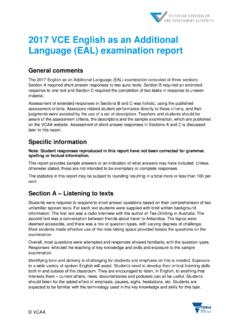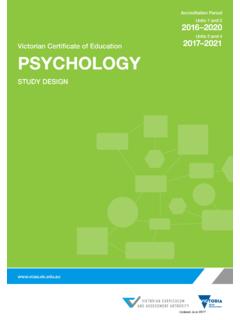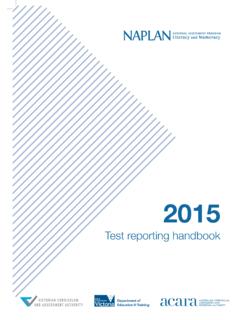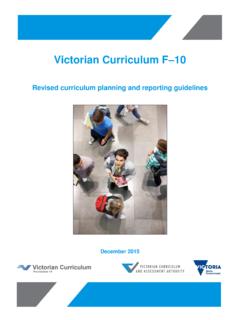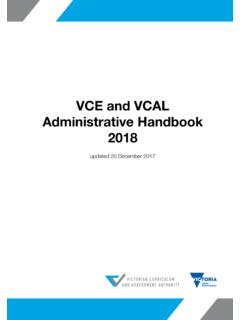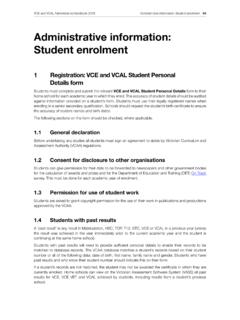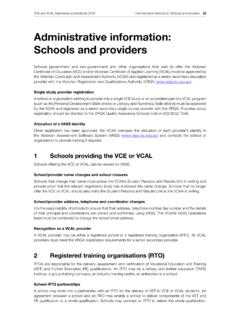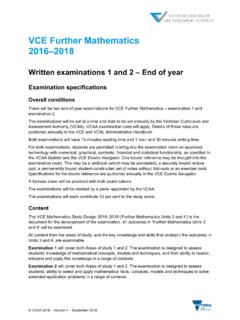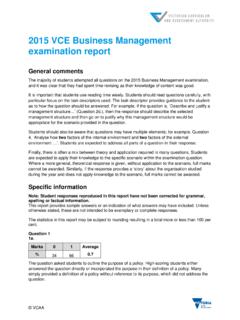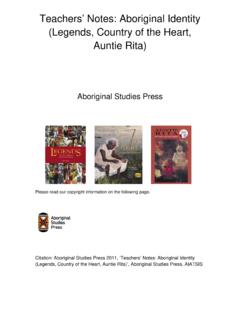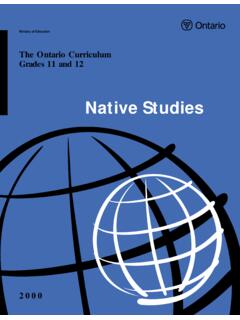Transcription of Victorian Aboriginal Languages - vcaa.vic.edu.au
1 Victorian Aboriginal Languages History Over two hundred Languages , and even more language varieties, were spoken in Australia prior to colonisation. Many of these Languages are no longer in everyday use; some are spoken only for special purposes (such as ceremonies), some Languages exist only in manuscripts, some are sleeping, and perhaps some are completely extinct. This loss of Australia's Aboriginal linguistic heritage is a direct result of contact with english . Language displacement and loss has particularly affected Victoria and Tasmania, where Aboriginal Languages are no longer spoken as the primary means of communication.
2 Even so, most Victorian Aboriginal people are aware of their language heritage, although some may recall only fragments of the language passed down over the several generations since english settlement. In the 19th century, information about the Aboriginal Languages of Victoria was recorded by clergymen, squatters, policemen and others who were in contact with Aboriginal people. In the 1960s, Luise Hercus recorded a number of Victorian Aboriginal people talking about their Languages on audio tape. These tapes are held at the Australian Institute of Aboriginal and Torres Strait Islander Studies (AIATSIS) in Canberra.
3 The Aboriginal Languages of Victoria are classified as Pama-Nyungan Languages , and, as such, share many characteristics with other Australian Languages , except for those in the Kimberleys and the Top End. This is important for those who are reconstructing, reclaiming and reviving Victorian Languages , because it gives them a framework within which to work. Within Victoria, some Languages have been identified as belonging to particular groups, and these are listed below. The most widespread of these are the Kulin Languages , and these Languages are all related, to varying degrees.
4 This means that researchers can compare the historical data for a given language with the other Languages in the same group, as they often share a lot of vocabulary, and, in some cases, even grammatical markers. Recently, Victorian Aboriginal people, together with linguists, have looked again at the material surviving for Victorian Languages . The following list indicates those Languages , and groups of Languages , for which language material has been identified. Language Group 1. Kulin a) Western Kulin (Western Victoria). Wemba Wemba (Swan Hill and Lake Boga).
5 Barababaraba (Gunbower Area). Madhi Madhi (Balranald area). Ladji Ladji (Mildura area). Wadi Wadi (Swan Hill). Wadi Wadi (Piangil). Wergaia (Wimmera). Djab Wurrung (Grampians). Dja Dja Wurrung (Loddon Valley). Jardwadjali (Upper Glenelg River). b) Eastern Kulin (Melbourne and surrounds). Taungurung/Thagungwurrung (Goulburn Valley - southern). Woiwurrung (Yarra Valley). Boon Wurrung (Coastal Melbourne and Westernport). Aboriginal Languages Victoria Portal for Aboriginal Language Reclamation & Research Page 1 of 9. c) Wathaurong/ Wathawurrung (Geelong/Barwon Valley area).
6 D) Gulidjan (Lake Colac area). 2. Warrnambool (Warrnambool Portland area). Dhauwurd Wurrung (Portland). Keerray Woorroong (Warrnambool). Tyakoort Woorroong (Camperdown). 3. Buandig (South West Victoria/Mt Gambier area). 4. Yorta Yorta/Bangerang and Yabula Yabula (Murray Goulburn area). 5. Dhudhuroa (High Country area). 6. Pallanganmiddang (Kiewa Valley area). 7. Gippsland area Gunnai Kurnai Brataualung (Corner Inlet area). Krauatungalung (Lake Tyers area). Brabralung (Mitchell River). Tatungalung (Gippsland Lakes). Braiakaulung (Latrobe River).
7 8. Ngarigu (Monaro-Snowy/Canberra and southwards into Northern Victorial area) is a separate language that extends into Northeastern Gippsland We cannot be precise about the boundaries of any language, as descriptions of the location for each language can overlap, be incorrectly recorded, or, in some cases, be non-existent. However, the Dreaming Stories belonging to some groups do assist in defining their country. Aboriginal Languages Victoria Portal for Aboriginal Language Reclamation & Research Page 2 of 9. Relatedness of Languages Blake and Reid (1998) classified over 200 historical sources into language groups, using a method called lexicostatistics, which compares the words from each group to the words of other groups, to see how similar they are.
8 They used at least 100 words of common vocabulary for each source, with the exception of Yabula Yabula, which has only a small amount of information available. If you look at the table below, you will see that no two language groups share more than 50% of the words used, which means that they can be considered to be separate language groups. Percentages of Common Vocabulary Between Language Groups WK BUAN WARR GULI WATH EK YY YAB DHU PALL GIPPS. Western - 31 42 31 44 41 15 23 22 20 16. Kulin Buandig - - 35 20 17 23 15 11 11 10 10.
9 Warrnam - - - 23 26 30 12 16 10 14 18. Gulidjan - - - - 34 32 17 11 19 20 19. Wathaurong - - - - - 46 15 15 14 16 18. Eastern - - - - - - 13 15 20 22 27. Kulin Yorta Yorta - - - - - - - 37 18 27 20. Yabula - - - - - - - - 18 20 14. Yabula Dhudhuroa - - - - - - - - - 31 13. Pallangan- - - - - - - - - - - 16. middang Gippsland - - - - - - - - - - - Aboriginal Languages Victoria Portal for Aboriginal Language Reclamation & Research Page 3 of 9. Research on the Reclamation of Victorian Languages In the last fifteen years, there has been a resurgence of interest by the Victorian Aboriginal people in their language heritage, as they assert their Aboriginal identity as emerging writers, playwrights, educators and scholars.
10 The recent success in 2005 of the land claim negotiated with the Government of Victoria and by the Wotjobulak Barenji Gadjin Land Council in the Western district of Victoria, has also been accompanied by community initiated language reclamation research. In 1992, the Victorian Curriculum and Assessment Authority (VCAA) responded to an Aboriginal request by the Worawa Aboriginal College to develop an accredited Year 11-12 Study on Aboriginal Languages . The Victorian Certificate of Education (VCE) study- Indigenous Languages of Victoria: Revival and Reclamation, was fully accredited in 2004 and requires students to learn where to find historical sources for Victorian Aboriginal Languages and acquire skills in analysing such materials as part of the language reclamation process.
